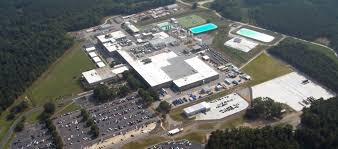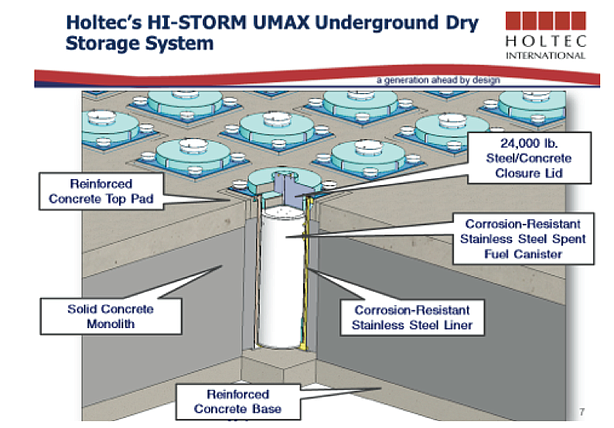
Blog
-
Geiger Readings for Aug 31, 2016
Ambient office = 108 nanosieverts per hourAmbient outside = 104 nanosieverts per hourSoil exposed to rain water = 104 nanosieverts per hourRomaine lettuce from Central Market = 90 nanosieverts per hourTap water = 94 nanosieverts per hourFiltered water = 87 nanosieverts per hour -
Nuclear Reactors 401 – Westinghouse Guilty Of Sloppy Housekeeping At Columbia Fuel Fabrication Facility
The Columbia Fuel Fabrication Facility is a factory in Columbia, South Carolina where nuclear fuel rods are manufactured for commercial nuclear power plants. The forty seven year old plant is owned and operated by Westinghouse. The facility occupies over half a million square feet and employs one thousand workers.
If uranium deposits build up in the wrong places in a nuclear fuel plant, it can pose a serious hazard. The uranium used in nuclear fuel rods can spontaneously combust if exposed to air and start a serious fire. If a buildup of uranium passes a threshold, there is the danger of a “critical event” which could release a burst of radiation that could pose a serious or even lethal threat to the health of workers nearby.
In 2004, the Nuclear Regulatory Commission fined Westinghouse twenty four thousand dollars because Westinghouse had allowed uranium to build up for eight years in an incinerator at the plant. The NRC concluded that Westinghouse did not properly assess the risk of a uranium buildup and did not set proper standards for monitoring the incinerator. As a result of the fine, Westinghouse invested three million dollars in improving the equipment at the plant including replacing the incinerator.
Westinghouse notified the NRC five weeks ago that they had discovered that one hundred and ninety one pounds of uranium had accumulated in one part of an air pollution scrubber system. This amount of uranium is more than three times the federal safety limit of eighty pounds. Westinghouse knew about the accumulation at the beginning of June but did not report it to the NRC until July. Questions have been raised about why it took Westinghouse a month to notify the NRC when such incidents are supposed to be reported within twenty four hours of discovery.
On August 7th, the NRC reported that “residual material” was discovered in an old air pollution scrubber component at the Columbia plant that had not been in use since 2002.
This week, Westinghouse notified the NRC that a safety inspection at the Columbia plant found another buildup of uranium in the air pollution scrubber system that may be beyond the safety limit.
The danger of a critical event caused by one of these three incidences of uranium accumulation was minimal facility because other conditions for a critical event were not met. It is unknown at that this time why these uranium accumulations occured. The incidents are being studied and a report will be issued this fall.
Until the reason for the uranium accumulation is discovered and dealt with, Westinghouse has shut down the chemical processing area where the contaminated air pollution scrubber system is located. One hundred and seventy workers will be laid off temporarily while the investigation proceeds and solutions are implemented.
NRC records show that the Westinghouse fuel plant has been the subject of twelve major NRC enforcement records since the late 1990s. A member of the Sierra Club who specializes in nuclear issues accused the company of being lax in the handling of nuclear materials. He said, “It sounds like sloppy house-keeping and poor maintenance.”
Columbia Fuel Fabrication Facility:
-
Geiger Readings for Aug 30, 2016
Ambient office = 125 nanosieverts per hourAmbient outside = 85 nanosieverts per hourSoil exposed to rain water = 86 nanosieverts per hourRomaine lettuce from Central Market = 72 nanosieverts per hourTap water = 79 nanosieverts per hourFiltered water = 67 nanosieverts per hour -
Radioactive Waste 190 – Holtec Building Dry Cask Storage For San Onofre Spent Fuel
The San Onofre Nuclear Generating Station was a nuclear power plant located near San Diego, California. It went operational in 1968, providing over two gigawatts of power to the grid. It was operated by Southern California Edison. In 2004, with San Onofre reaching the end of its licensed lifespan, the owners went to the California utility regulators and proposed an upgrade for the facility to allow it to operate for decades more. Despite some opposition, the utility regulators agreed. The NRC was also approached for permission to proceed with the upgrade with the understanding that no significant changes were to made to the steam turbines that needed to be replaced.
Mitsubishi Heavy Industries was contracted to build the replacement turbines. Despite what the NRC had been told, there were design changes in the turbines that caused MHI express concern over the integrity of the new design. The new turbines were built and installed. Within two years, a steam pipe ruptured due to vibrations and released radioactive materials. It was decided that it would not be cost effected to replace the steam turbines again and the plant was shut down in 2013. Law suits and debates on the disposition of spent fuel followed.
Due to the fact that there was no permanent geological repository for spent nuclear fuel in the U.S., it was decided to place the spent fuel in dry casks for storage at the San Onofre site. It was estimated that it would take about five years and over four billion dollars to bury millions of tons of spent fuel at San Onofre. The fuel is expected to remain there for at least thirty five years. Despite public backlash against storing all that radioactive materials close to the ocean, the project is proceeding.
Holtec will utilize their new Hi-Storm Umax dry-cask storage systems for this project. A reinforced concrete pad has been constructed at San Onofre. Seventy five giant concrete tubes will be placed on the pad, bolted in and then surrounded by concrete. When the cooling pools containing the twenty six hundred fuel assemblies are opened, huge storage canisters will be lowered into the pool. Thirty seven fuel assemblies will be loaded into each canister. The canisters will be inserted into transfer casks which will be lifted out of the pools and drained.
Trucks will carry the canisters to the Umax installation and lowered into the giant tubes which will be capped when full. A twelve ton lid of concrete and steel will be placed atop the tubes and earth will be piled around the whole construction.
One and a quarter billion dollars have been set aside for spent fuel management. The operators at San Onofre hope that the U.S. government makes good on its promise to create a permanent geological repository for spent nuclear fuel by 2050 so they can remove the spent fuel from San Onofre.
Critics are worried about the ability of the casks to safely contain what is referred to as “high burn-up” spent fuel. The use of nuclear fuel with a higher percentage of U-235 came into use a few decades ago. It allows the nuclear plant operators to get more power from the fuel before it needs to be replaced which is expensive and time consuming. Because this is a relatively new practice, its is not well known how well dry-cask will be able to cope with the greater heat and radioactivity of the spent fuel. The critics are worried that the moist salty environment close to the ocean could result in a greater tendency of the canisters to crack. They want Holtec to use casks with thicker sides as is mandated in some other countries storing spent nuclear fuel in casks.
-
Geiger Readings for Aug 29, 2016
Ambient office = 123 nanosieverts per hourAmbient outside = 99 nanosieverts per hourSoil exposed to rain water = 89 nanosieverts per hourMango from Central Market = 94 nanosieverts per hourTap water = 101 nanosieverts per hourFiltered water = 82 nanosieverts per hour -
Nuclear News Roundup Aug 28, 2016
Iran Arrests Member Of Nuclear Deal Negotiation Team nuclear-news.net
THE police force charged with guarding UK nuclear power plants has admitted to a substantial increase in the number of breaches of security last year. nuclear-news.net
Chinese, British energy officials discuss Hinkley Point nuclear project reuters.com
A MUSHROOM cloud sparked panic in Siberia yesterday, terrifying residents who feared a nuclear attack. express.co.uk
-
Geiger Readings for Aug 28, 2016
Ambient office = 66 nanosieverts per hourAmbient outside = 107 nanosieverts per hourSoil exposed to rain water = 121 nanosieverts per hourOrange bell pepper from Central Market = 93 nanosieverts per hourTap water = 86 nanosieverts per hourFiltered water = 73 nanosieverts per hour





